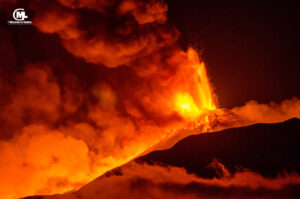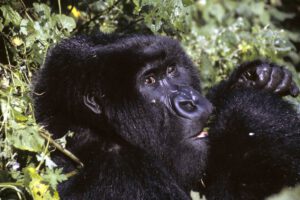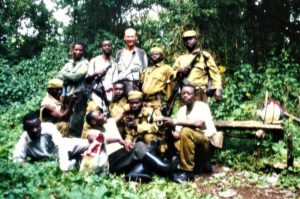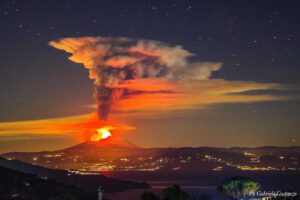 Guatemalan volcano Pacaya erupted another ash cloud today. It rose to an altitude of 3000 m and drifted in a westerly direction. Yesterday INSIVUMEH reported strombolian eruptions from McKenney crater. Incandescent tephra was spewed a good 175 m above crater level. The lava flow on the southern flank reached a length of a proud 1725 m. MIROVA indicates high thermal radiation. INSIVUMEH warns not to enter the south side of the volcano. The photo was published on February 21.
Guatemalan volcano Pacaya erupted another ash cloud today. It rose to an altitude of 3000 m and drifted in a westerly direction. Yesterday INSIVUMEH reported strombolian eruptions from McKenney crater. Incandescent tephra was spewed a good 175 m above crater level. The lava flow on the southern flank reached a length of a proud 1725 m. MIROVA indicates high thermal radiation. INSIVUMEH warns not to enter the south side of the volcano. The photo was published on February 21.
 Marc Szeglat
Marc Szeglat
Etna paroxysm no. 7 starts
Update 10:15 am: The paroxysm has already ended and only steam is emitted. The most beautiful view was probably from the north. From the south it was very hazy. The paroxysm built up very quickly and practically without warning and lasted only about 1 hour. It was the shortest paroxysm of the series so far. Since it was practically windless, the ash cloud dominated this time. Red-hot tephra was hidden by it, and less red-hot material was erupted than usual. This is also evidenced by the relatively small lava flow that entered Valle del Bove. Towards the south, no lava at all was on its way this time.
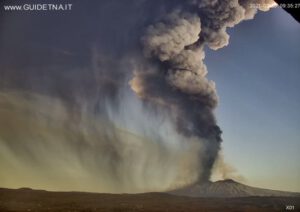 The tremor amplitude reached a high value and was even minimally higher than during the last eruption. In summary, gas pressure was high, but less magma was erupted than in the other paroxysms. The material was more fragmented. Exact data about the height of the eruption cloud are unfortunately missing so far. The VAAC Toulouse issued 2 reports, but apparently detected the eruption only during its initial phase. Likewise values about the thermal radiation are missing. But the pictures say more than a thousand words anyway.
The tremor amplitude reached a high value and was even minimally higher than during the last eruption. In summary, gas pressure was high, but less magma was erupted than in the other paroxysms. The material was more fragmented. Exact data about the height of the eruption cloud are unfortunately missing so far. The VAAC Toulouse issued 2 reports, but apparently detected the eruption only during its initial phase. Likewise values about the thermal radiation are missing. But the pictures say more than a thousand words anyway.
Update 9:30 a.m.: The paroxysm is heading towards its peak, producing a breathtaking eruption cloud. The LiveCam with the best view is linked here. Below you can see the livestream from Localteam. Unfortunately it is very hazy in the south of the volcano, so the view is a bit cloudy.
Original news: 9:15 a.m.: This morning Etna is on the move with its 7th consecutive paroxysm. Without any omens, the tremor started to increase sharply and with absolutely no wind, a lava fountain is currently (9:15 am) building up along with an ash cloud. The paroxysm came much later than the statistics would have suggested. This shows once more that nature remains unpredictable in the end.
Strong earthquake shakes Iceland
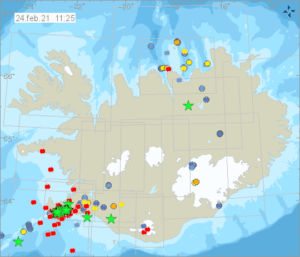 This morning Iceland was shaken by a strong earthquake of magnitude 5.7. The hypocenter was located at a depth of only 1.1 km, according to IMO. The epicenter was located on the Reykjanes Peninsula, more precisely, 3.3 km south-south-west of Keilir. This is a mountain of volcanic hyaloclasti. These are fragments of volcanic glass. Keilir is located about 10 km northeast of Grindavik and thus in the area that has been hit by inflation-related earthquakes since the beginning of last year. However, the magnitude of the current main earthquake suggests that the origin was tectonic in nature. However, it could be that the ground deformation triggered by inflation caused stresses and thus a fault zone was activated. But this is so far only speculation on my part. Therefore, I am eagerly awaiting a report from IMO to assess the situation.
This morning Iceland was shaken by a strong earthquake of magnitude 5.7. The hypocenter was located at a depth of only 1.1 km, according to IMO. The epicenter was located on the Reykjanes Peninsula, more precisely, 3.3 km south-south-west of Keilir. This is a mountain of volcanic hyaloclasti. These are fragments of volcanic glass. Keilir is located about 10 km northeast of Grindavik and thus in the area that has been hit by inflation-related earthquakes since the beginning of last year. However, the magnitude of the current main earthquake suggests that the origin was tectonic in nature. However, it could be that the ground deformation triggered by inflation caused stresses and thus a fault zone was activated. But this is so far only speculation on my part. Therefore, I am eagerly awaiting a report from IMO to assess the situation.
There were numerous pre- and aftershocks. Among the aftershocks, there were 34 tremors with magnitudes greater than 3. IMO has so far registered a total of 378 tremors in the affected region within 48 hours.
The earthquake occurred at 10:05 UCT. It was felt in a wide radius. There are no reports of damage yet.
Volcano update 23.02.21: Etna paroxysm
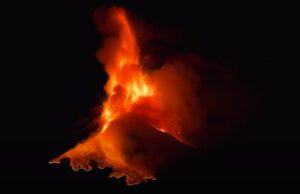 The 5th Etna paroxysm in direct succession was also the one that produced the strongest tremor signal. The height of the lava fountain was comparable to that of the last eruption, reaching heights of between 800 – 1000 m. Thus, this paroxysm was also among the strongest representatives of its kind. The VAAC detected volcanic ash at an altitude of 10,000 m. The tephra rained down on the volcanic flanks in the communities and meanwhile covered whole streets. Lava flows flowed in different directions. The largest flowed into the Valle del Bove. Towards the south a moderate flow was on its way and even in the northern direction some lava flowed. It is striking from the course of the tremor that there was a further peak after the actual paroxysm. The associated infrasound signals manifested themselves around 4:00 UCT. Less pronounced tremor peaks can also be detected during the last two paroxysms. Currently, the volcano has not yet calmed down completely and is emitting small ash eruptions. Intense afterglow can be seen on the thermal cams.
The 5th Etna paroxysm in direct succession was also the one that produced the strongest tremor signal. The height of the lava fountain was comparable to that of the last eruption, reaching heights of between 800 – 1000 m. Thus, this paroxysm was also among the strongest representatives of its kind. The VAAC detected volcanic ash at an altitude of 10,000 m. The tephra rained down on the volcanic flanks in the communities and meanwhile covered whole streets. Lava flows flowed in different directions. The largest flowed into the Valle del Bove. Towards the south a moderate flow was on its way and even in the northern direction some lava flowed. It is striking from the course of the tremor that there was a further peak after the actual paroxysm. The associated infrasound signals manifested themselves around 4:00 UCT. Less pronounced tremor peaks can also be detected during the last two paroxysms. Currently, the volcano has not yet calmed down completely and is emitting small ash eruptions. Intense afterglow can be seen on the thermal cams.
Etna: New paroxysm at the start
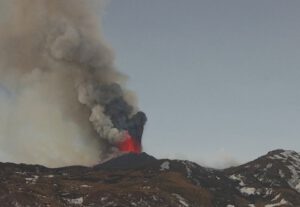 Update 9:50 a.m.: The paroxysm is now probably almost unstoppable. On the LiveCam you can already see a small lava fountain rising at the New Southeast Crater. The eruption is developing very fast and is already heading towards the peak phase. And this again in the most beautiful volcano watching weather!
Update 9:50 a.m.: The paroxysm is now probably almost unstoppable. On the LiveCam you can already see a small lava fountain rising at the New Southeast Crater. The eruption is developing very fast and is already heading towards the peak phase. And this again in the most beautiful volcano watching weather!
Original message 9:15 a.m.: Currently, it looks as if another paroxysm is at the start at Etna in Sicily. Around 9:15 CET, not only the tremor increased significantly, but continuous strombolian eruptions started and the lava output increased significantly. Of course, the eruption can still stall, but so far it looks like a paroxysm is approaching fairly quickly.
Etna: New paroxysm on 17 February
Last night, Etna in Sicily produced another paroxysm. Virtually without warning, the tremor shot up at 21.15 UCT (22.15 CET) and already an hour later the eruption was heading towards its peak. A lava fountain was again produced from New Southeast Crater and multiple lava flows were underway. This time, the lava flowed not only into Valle del Bove, but also in a southerly direction. VAAC detected volcanic ash at an altitude of 10,000 m. The tremor amplitude was a bit larger than during the February 16 paroxysm. MIROVA registered an extremely high thermal radiation with a power of 17,000 MW! Indeed a very extreme value and I don’t remember to have seen something like that at Etna in recent times. Even now it is quite hot in the area of New Southeast Crater, which can be seen nicely on ThermalCam. In the latest Sentinel satellite photo from February 16, hot vents can be seen in all 4 summit craters.
This eruption confirms once again that it is virtually impossible to predict these paroxysms by statistics. Yesterday I postulated an eruption interval of almost 4 weeks, this time the next eruption came after 28 hours. It would not be atypical if we would see more outbreaks in the short term, but of course the break interval may lengthen again, or shorten even further.
In Our FB group, numerous media were shared again
Etna: Paroxysm of 16.02.21
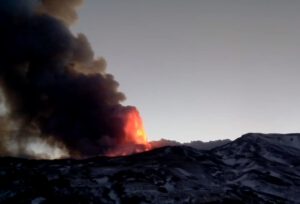 After Tuesday’s paroxysm, Etna is in a hangover mood today. The tremor has fallen to a multi-week low, moving at the base of the yellow range. The tremor curve gives a good indication of how short-lived the peak phase of the paroxysm was. This one was a moderate representative of its kind: the lava fountain reached a maximum height of just over 500 m and the main phase lasted less than an hour. What made the eruption special were the good visibility conditions and that it occurred at dusk. Accordingly, many media were shared in the social networks, some of which I would like to present to you here. From a posting by volcanologist Boris Behncke, it can also be seen that not only photos and videos were shared on social media, but also a lot of fake news that worried residents of the region. As spectacular as the paroxysm looked, it was not an unusual event that heralds a major disaster like a strong earthquake, or a flank eruption. A flank eruption will of course occur again sooner or later on Etna, and the Damocles sword of a strong earthquake always hovers over Sicily, but there is no direct link between yesterday’s eruption and possible tectonic earthquakes in Sicily.
After Tuesday’s paroxysm, Etna is in a hangover mood today. The tremor has fallen to a multi-week low, moving at the base of the yellow range. The tremor curve gives a good indication of how short-lived the peak phase of the paroxysm was. This one was a moderate representative of its kind: the lava fountain reached a maximum height of just over 500 m and the main phase lasted less than an hour. What made the eruption special were the good visibility conditions and that it occurred at dusk. Accordingly, many media were shared in the social networks, some of which I would like to present to you here. From a posting by volcanologist Boris Behncke, it can also be seen that not only photos and videos were shared on social media, but also a lot of fake news that worried residents of the region. As spectacular as the paroxysm looked, it was not an unusual event that heralds a major disaster like a strong earthquake, or a flank eruption. A flank eruption will of course occur again sooner or later on Etna, and the Damocles sword of a strong earthquake always hovers over Sicily, but there is no direct link between yesterday’s eruption and possible tectonic earthquakes in Sicily.
Strong earthquake Mw 7.6 shakes Loyalty Islands
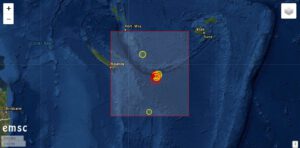 The Loyalty Islands region has just been shaken (13:19:57 UTC) by a strong earthquake of magnitude 7.6. The epicenter was located 401 km east of Tadine on New Caledonia. The earthquake focus was located at a depth of only 2 km. Should the information be confirmed, then in my opinion a tsunami is imminent. The strong earthquake was preceded by several quakes with magnitudes between 6.2 and 5.7.
The Loyalty Islands region has just been shaken (13:19:57 UTC) by a strong earthquake of magnitude 7.6. The epicenter was located 401 km east of Tadine on New Caledonia. The earthquake focus was located at a depth of only 2 km. Should the information be confirmed, then in my opinion a tsunami is imminent. The strong earthquake was preceded by several quakes with magnitudes between 6.2 and 5.7.
Semeru: Lahar swept away car
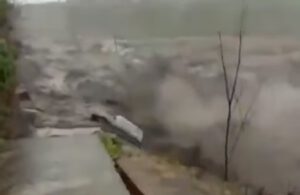 A lahar formed at the Javanese volcano Semeru the day before yesterday. The mud flow swept away a car and sank it in a riverbed near the village of Supiturang. The parked car was on a small path at the edge of the river and was loaded with diesel for mining machinery. The driver was in the sand mine on the slope of the volcano and remained uninjured. However, the fuel is believed to have been released and is polluting the environment. Sand mines are found at many volcanoes in Indonesia. Here volcanic sand is extracted, but also gravel for road construction.
A lahar formed at the Javanese volcano Semeru the day before yesterday. The mud flow swept away a car and sank it in a riverbed near the village of Supiturang. The parked car was on a small path at the edge of the river and was loaded with diesel for mining machinery. The driver was in the sand mine on the slope of the volcano and remained uninjured. However, the fuel is believed to have been released and is polluting the environment. Sand mines are found at many volcanoes in Indonesia. Here volcanic sand is extracted, but also gravel for road construction.
Lahars are formed when water (usually as a result of heavy rainfall) mobilizes volcanic deposits on the slope.
Semeru has been particularly active again since early February. The VSI registers about 80 seismic eruption signals daily, but also volcanic tremor.
Otra inundación de lava fría del monte Semeru acaba de golpear la aldea de Supiturang en Lumajang, Java Oriental, durante las fuertes lluvias de hoy. No se reportan víctimas.
Vídeo Bma Pachuau pic.twitter.com/TA7LnmBy5s
— Alerta Cambio Climático (@AlertaCambio) February 8, 2021
Adventurous journey to Nyiragongo in 1996
Author Chris Weber
Here you can read the first part of a series about the volcanoes in the East African Rift Valley. The reports come from the volcano guide Chris Weber.
African Rift Valley East
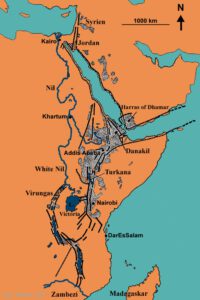 The East African Rift system extends from the Jordan Valley through the Red Sea, southwards through East Africa and then along the Zambezi River. This system is about 6500 km long. The active continental rift volcanism in East Africa created great faults with an average width of 50-60 km. In places, parts of the earth’s crust has sunk, while in other places the edges of the trench has been lifted up.
The East African Rift system extends from the Jordan Valley through the Red Sea, southwards through East Africa and then along the Zambezi River. This system is about 6500 km long. The active continental rift volcanism in East Africa created great faults with an average width of 50-60 km. In places, parts of the earth’s crust has sunk, while in other places the edges of the trench has been lifted up.
As a result, the altitude of the bottom of the trench varies from 600-900 meters below the trench shoulders. In some areas this difference in altitude is even up to 3000 meters. Sediments and lava have partially filled the rift over millions of years.
Turning inland from the Red Sea into Ethiopia, the rift is dividing the country into the highlands to the west and lower desert to the east. Then in Kenya and Uganda two separate branches go apart and join together at their southern end in southern Tanzania along its border with Zambia. The Western Rift is also called the Albertinen Rift, including the Ruwenzori Range, plus the Mitumba and Virunga Mountains. The deepest valleys are found to the north of Kenyas capital Niarobi.
The most of the great rift lake was formed as the result of the rift-system, and lies in territories within the rift. Lake Victoria is considered to be part of the rift-valley-system, although its found actually between the two rift branches. The most rift lakes have high mineral contents as result of evaporation of water, like Lake Magadi with a high concentration of soda, meanwhile Lake Bogoria and Lake Natron are all strongly alkaline, while freshwater springs who supply the lake Naivasha do support the current biological variety. The southern section of the Rift Valley with lake Malawi hosts the third deepest freshwater lake in the world and reaches 706 metres surface to bottom.
The two major gateway-towns of the East African Rift are Nairobi in Kenya and Addis Abeba in Ethiopia.
Continental Rift Volcanism
The East African Rift is the most important example of continental rift volcanism. Another good example is the Upper Rhein Graben (rift) in Germany. But much more widespread or predominant on Earth is the mid-ocean rift volcanism usually deep down in the oceans. This is the same geophysical principle of earth plates drifting apart, but differs in the uplifting rock melt (magma).
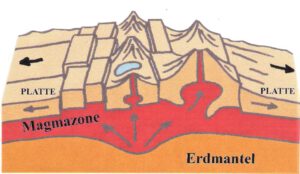 Continental rift volcanism arises where convection currents in the interior of the earth drive the continental lithospheric plates (earth’s crustal plates) apart. The so formed fracture gaps are then filled up with volcanic products from the earth’s interior. Volcanoes arise and floods of magma pour into the fractures as viscose lava flows.
Continental rift volcanism arises where convection currents in the interior of the earth drive the continental lithospheric plates (earth’s crustal plates) apart. The so formed fracture gaps are then filled up with volcanic products from the earth’s interior. Volcanoes arise and floods of magma pour into the fractures as viscose lava flows.
This process can stretch over hundreds of millions of years and might be accompanied by epochs of immobility. With the current examples of the East African Rift and the Upper Rhein Rift, which today are apparently subject to a small spreading scale, nevertheless, one day the subcontinent could migrate apart so that a new ocean is created.
Adventures around the volcanoes of East Africa
The Virunga volcanoes (1996 and 2011)
Part 1: Gorillas of Zaire (Rep. Kongo)
After I had eaten dust being whirled up by some UN trucks with goods for the refugees in Goma, while sitting on an open pickup truck which had given me a lift, public transport stopped finally at the frontier-post between Uganda and East Zaire. So I had to hire a local guide to continue on foot. We went through lush farmland up on the slopes of Sabinyo volcano.
This mountain and the neighboring Virunga volcanoes of Muhavura, Gahinga, just north of Sabinyo, and Visoke, Karisimbi (the highest with 4507m) and Mikeno to the south, give home to the last about remaining 600 mountain gorillas (Gorilla beringe). They hide at higher altitudes of those volcanoes in the tropical so-called cloud forest, forming a fairly tale scenic atmosphere.
One day of hard and rough walking along narrow footpaths, luckily free of landmines, brought me up to the cloud forest line of Mikeno. There I had to pay a 130 US fee cash at the basic ranger station to take off the next day visiting the gorillas with an armed patrol. Well, good invested money, to keep the primates protected against poachers, hungry soldiers or refugees. Therefore, most of the gorilla families have armed rangers living with them all along the time.
It was early morning when we took off into the mysterious jungle, following the gorillas´ tracks through thick forest for hours. Finally, we arrived at an opening where a big family group of 25 gorillas were feeding and relaxing. A half ton silver back, hat of this group, washed from time to time, while gorilla babies were coming closer to check my photo equipment and my laces. After two hours or so, we left these nice creatures excited and fascinated.
I walked down from these volcanoes and met the paved road to Goma, when an overloaded pickup truck stopped to pick me up. Our truck got stopped three times on a few kilometers and on the third stop zairen soldiers ordered me to hop of. The driver of the truck said sorry and drove off. I know, that the zairen soldiers got paid by their government in invalided money such as the Zaire and that’s because of hunger they kill wild animals and steal in villages, even once they looted and ruined Goma.
So, I was quite nervous when some lousy looking soldiers escorted me in a dark hut of the road, standing in front of a greening hire raked officer. I explained, that the only reason to come here was the attempt to climb the volcano Nyiragongo, that’s why I was wearing military boots. I knew ahead, that these shoes would have had brought some trouble to me in East Africa. So I had to pay my way out by little cash and cigarettes. John, a local translator for care-oganisations and journalists told me some days later in Goma, that it’s impossible to get any kind of good shoes around Goma.
In the surrounding of Goma huge refugee camps with kilometers of space hosted some hundreds of thousands of Hutus who had started an exodus from Rwanda into Zaire in the 1970’s after first massacres took place by the Tutsi minority. Then, after many incidences in 1994, the Hutu took revenge and killed 75 percent of the Tutsi and moderate Hutus. Only in June and July up to 1 million people were killed. Finally, the rebel group RPF took over in Rwanda and installed a Tutsi government again, causing countless Hutu to flee out of the country.
Part 2: Nyiragongo volcano hike
There was little to say about Goma itself, because this ruined town was a total mess with hotels and restaurants closed, shops empty and a UN organization (peace and aid force) behind many high fence lines. After one night in Goma without any food except Coca-Cola, I went out on the road again to reach the foot of Nyiragongo. It was out of the question to climb up the volcano without guide and armed force, because of gang (bandits) activities around volcanoes such as RPF rebels and others.
So I went to the national park headquarter asking for help. Two remained officers were surprised to see me as a visitor, but the very nice Mr. Kivuya Wa Viui agreed to join me up the volcano after a long conversation and after paying the 100 US fee for hiking the mountain, plus some extra for my guide. Maybe the only incoming for Kivuya since many month. At a nearby zairen military post we found luckily a solution to get a well armed group. The chef officer was so amazed of my crazy wish to clime Nyiragogo, that he ordered a dozen soldiers for this expedition.
I wasn’t really sure about of putting my life and my army boots into the hand of a group of Rambos with no shoes. Well, there was one more problem, my leek of any food. But after checking this young guys out and the fact, that this forests are hiding places for Hutu and Tutsi, gave me no other option. For this evening Mr. Kivuay gave me some food and a place to lay down my sleeping bag.
Our expedition started by early morning, and it was my best armed ever with an amazing variety of weapons. Soon we entered the jungle at its best with heat, humidity, crying monkeys and crazy loud zikades. During a break, I pulled out my photo camera and instantly watched into the soldiers big eyes. Well, for sure it was in their eyes a fortune. But they made jokes about in the next minute and asked for a group picture all together. Then they gave me some of their food, an unknown paste of sweet rood.
We walked up a slippy path under combat conditions with one little group well ahead of us, when suddenly loud gun fire started. I stopped breathing, went down and listened, meanwhile some soldiers rushed up the path. The exhausting tracking was forgotten for the moment. I looked to Kivuay next to me. He was shaking his head and asked a soldier with whispering voice. Then he greened to me and explained, that it was just a salute for a shot comrade a while ago. Well thanks, thought I.
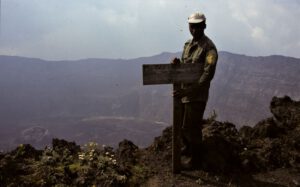 We reached a hut half an hour below the crater rim after 5 hours of tracking. Me and the armed ranger Kivuay agreed that the soldiers would return slowly back down the volcano. No, rebels, they said, not asking for a single Dollar. Well, only bush land was on the upper slopes of 3470 m high Nyiragongo, and it was quite cold already. Mr. Kivuay and I went up to the crater rim for some hours, so that I could document the geological situation of the volcano.
We reached a hut half an hour below the crater rim after 5 hours of tracking. Me and the armed ranger Kivuay agreed that the soldiers would return slowly back down the volcano. No, rebels, they said, not asking for a single Dollar. Well, only bush land was on the upper slopes of 3470 m high Nyiragongo, and it was quite cold already. Mr. Kivuay and I went up to the crater rim for some hours, so that I could document the geological situation of the volcano.
For this night we returned to a little and cold hut with open door and window. It was awful only with a bed of leaves. The following morning we went up again for some pictures, then we started our descent. Halfway down Kivuay pulled me of the track deep into the bushes and me getting down and being quite, so did I. Some soldiers passed by. At the ranger post Kivuay explained to me, that he was afraid of friendly fire. I left my body with an extra tip, paid my way via Goma to the frontier of Rwanda.
Part 3: Through Ruanda
Crossing for Zaire into Rwanda these days meant unpacking the backpack at cable military checkpoint and explaining my reason of travel, as well why I carried a meter long bush knife (sometimes I asked myself too) and what I’m supposed to do with my photo camera. I managed angrily and sweatingly to answer this and reached the border town Gisenyi, got a hotel and some food. At rising dawn I went out to take a few pictures of destroyed military machinery from Rwandas conflicts, well knowing that I had to be careful by doing this. But the streets were empty in my opinion, so I took pictures.
When I started to walk back two military guys came across towards me. Oh oh, I thought. They said, ‘it’s forbidden to take pictures in Gisenyi’ and asked for my camera. I said no and that I was only taking pictures of the sun set over lake Kivu. They escorted me to a closed by police station. Another military showed up and after a discussion they asked at least for the film roll in my camera. To give the roll away with the of Nyiragogo and Gorillas was out of the question. We argued I asked of higher rank officer again, and again They agreed and two of them went out and off.
That was my chance. I said ‘I need to go to toilet’ and to my surprise they had one in the station, even a real flushing one, and let me go. I closed the door, pulled out my camera, flushed the toilet, pushed the rewind button the camera motor did so, took the film roll out, a new inside, closed, flushed again and went out. The militaries ignored me and the matter of fact, that I was sweating like hell. Soon after, an angry officer showed up and asked for the film roll. Well, I took it out and handed it over to him, then I left. The laugh was on my side for right now.
There was for sure no photo shop to develop my film roll, nevertheless I didn´t sleep well that night. I left Gisenyi at dusk without breakfast on a big truck towards the frontier of Tanzania. Countless military stops and the frontier paper work took me all day long. Luckily I got another truck on the Tanzanian side, where a million refugees camped along the road since over two years. In one center of those disaster camps I had to hop off the truck already by night. So far safe, but hungry and tired.
The nice truck driver asked for me around where to spend the night. An English-speaking guy showed me a place in a tent and a bizarre cinema where I found food and a coke-cola. Maybe 50 relatively privileged or so, watched quite silently the movie ‘Over the top’ with the actor Sylvester Stallone on a small TV. The Entrance fee of the cine was a quarter of a Dollar. This unreal situation made me some tears coming into my eyes. I left this burned, sad and tortured land towards the Serengeti, crossed the national park and reached the town Arusha, an urban paradise in compare.
Abstract
The 3470 m high strato volcano Nyiragongo is part of the Virunga mountains, which consist of 8 volcanoes. One of Africa’s most notable active volcanoes contained a lava lake from time to time in its deep summit crater.This lava lake was exsisting for half a century before outer flanks draining catastrophically in 1977. The steep slopes of a volcano are in contrast to the lower profile of the neighboring shield volcano Nyamuragira to the north. The 1.2 km wide summit crater has benches in the steep walled. Mark levels of former lava lakes, which have been observed since the late 19th century are found. The older strato volcanoes of Baruta and Shaheru are overlapped by the recent Nyiragongo and partially still seen on the north and south. Around 100 parasitic cones are located along radial fissures as far as Lake Kivu to the south. Many cones are buried by lava flows already, that extend long distances down the flanks, In 1977, the extremely fluid lava flows caused many fatalities on the south-east flank. The fluid lava flows towards the south in January 2002, destroyed a major portions of the city of Goma at lake Kivu.
Activity Reports
Observation on 3 August 1996.
Christoph Weber visited the volcano on 3 August 1996 and made a rough sketch map. Weber also saw no new activity. Features in the crater area included a spatter cone, a feature bordered on its S side with a light gray lava flow (dark shading 1). This flow was apparently the last erupted prior to the visit and it still showed fresh-looking flow channels. Weak fumaroles were located along the SE crater’s wall at concentric fractures ~50-150 m below the crater rim. Weber also relayed that seismologist Mahinda Kasereka had seen typical seismicity around this time interval
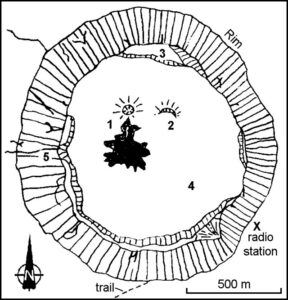 Members of an SVE excursion who climbed Nyiragongo during the second week of April 1996 found also no visible eruptive activity. They heard from local residents that the eruption that began in June 1994 (BGVN 19:06-19:08) had ended in September 1995. Whether the eruption actually ceased in September 1995 is ambiguous because Dario Tedesco learned that in November 1995 and in February-March 1996 observers saw glow above the crater at night. Also, Tedesco learned that some tourists spending the night near the summit during this same post-September interval allegedly saw minor activity. Some sustained seismic activity was reported in September through early December 1995 (BGVN 21:01).
Members of an SVE excursion who climbed Nyiragongo during the second week of April 1996 found also no visible eruptive activity. They heard from local residents that the eruption that began in June 1994 (BGVN 19:06-19:08) had ended in September 1995. Whether the eruption actually ceased in September 1995 is ambiguous because Dario Tedesco learned that in November 1995 and in February-March 1996 observers saw glow above the crater at night. Also, Tedesco learned that some tourists spending the night near the summit during this same post-September interval allegedly saw minor activity. Some sustained seismic activity was reported in September through early December 1995 (BGVN 21:01).
Figure below: Nyiragongo sketch map showing the crater in August 1996. Symbols are as follows: 1) Spatter cone with last lava flows (shaded); 2) spatter half-cone; 3) first platform (or bench, ~175 m below the crater rim); 4) surface of chilled lava lake and associated lava flows (~275 m below the rim); and 5) dikes. Courtesy of Christoph Weber.
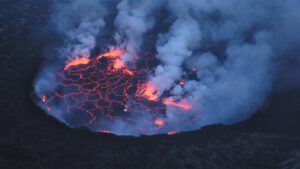 Observations in January 2011. Chris Weber visited Nyiragongo with an expedition group from 19 until 22 Jan. 2011. Lava lake activity of the last years continued into January. The first platform from the eastern crater rim at 3420 m was still ~175 m below and marked the post-1977 level. The lowest platform inside the crater was at 3020 m (level of post-2002), which made a total of ~400 m. A high dynamics lava lake, consisted of the lava fountains, measured roughly 200 diameter and was hosted behind an 20 m high ring wall built by lava spattering.
Observations in January 2011. Chris Weber visited Nyiragongo with an expedition group from 19 until 22 Jan. 2011. Lava lake activity of the last years continued into January. The first platform from the eastern crater rim at 3420 m was still ~175 m below and marked the post-1977 level. The lowest platform inside the crater was at 3020 m (level of post-2002), which made a total of ~400 m. A high dynamics lava lake, consisted of the lava fountains, measured roughly 200 diameter and was hosted behind an 20 m high ring wall built by lava spattering.
References
The following references have all been used during the compilation of data for this volcano, it is not a comprehensive bibliography.
Krafft M, 1990. Fuhrer zu den Virunga-Vulkanen. Stuttgart: Ferdinand Enke
Global Volcanism Program (GVP), 1996. Bulletin of Global Volcanism Network (BGVN), Smithsonian Institution
